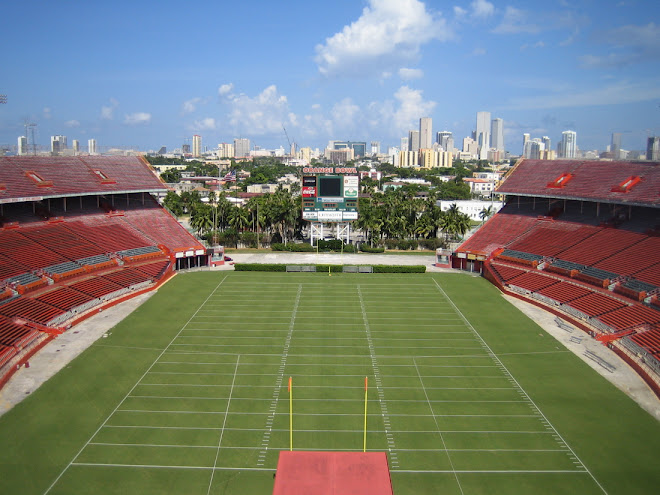
November 24, 1950: Members of the University of Miami's homecoming court were among the 45,000 fans who watched the Canes beat Iowa 14-6.
Over the years, I've collected many photographs of the Orange Bowl Stadium from surfing the net. This picture was taken during the University of Miami's homecoming football game against Iowa back in 1950. After doing a little research, this game was historically significant. Yet few people know about it.
Miami in 1950, like much of the South, was a segregated city. There were strict Jim Crow laws that prohibited blacks and whites from gathering and participating at the same functions. But on November 24, 1950, something new happened for the first time in the Orange Bowl Stadium. White and black athletes would compete on the same field.
The University of Iowa brought its football team to Miami to play the Hurricanes. At the time, Iowa had five African-American players on its roster. The University of Miami remained all-white. According to the University of Miami football media guide, UM had canceled games in the past against schools with black athletes. Games against Penn State and UCLA were specifically canceled in the 1940s. The UCLA cancellation was noteworthy because one of its African-American players happened to be Jackie Robinson--the same Jackie Robinson who later broke Major League Baseball's color barrier.
But in 1950, the University of Miami finally began to relax its segregational policies. Black fans were allowed to watch games at the Orange Bowl. But they were designated to only certain areas of the stadium--including the east end zone. The Hurricanes would beat Iowa 14-6 that evening. But late in the fourth quarter, one of Iowa's black players, sophomore halfback Bernie Bennett, scored a touchdown for the Hawkeyes. He happened to score in the east end zone, where a jubilant group of black spectators erupted in cheers.
"We were aware that we were setting a precedent," Bennett recalled. "But nothing happened during the game that reflected any conflict. There was no special security and there was no racist remarks. Once the game started, we just played."
While the game was played without any negative incidents or taunting, the trip to Miami wasn't routine. Bennett and his fellow black teammates were forced to stay in a separate hotel in the black section of town. Miami still had a long way to go at the time. It would be another 17 years before receiver Ray Bellamy would become Miami's first black football player.

3 comments:
This is a great Orange Bowl story. I did not know any of this.
This is Fawzy, by the way.lol
I enjoy how you use the blog to chronicle Miami's history - good job!
Post a Comment